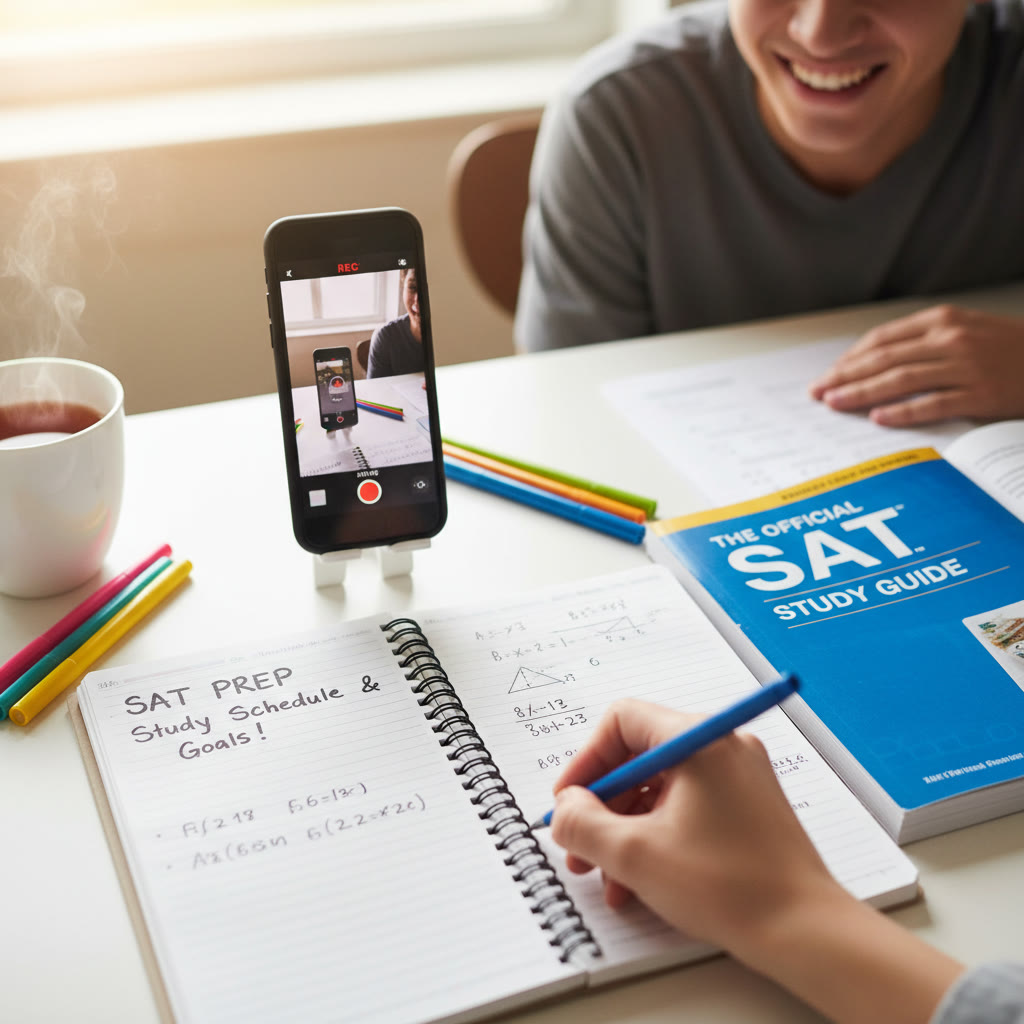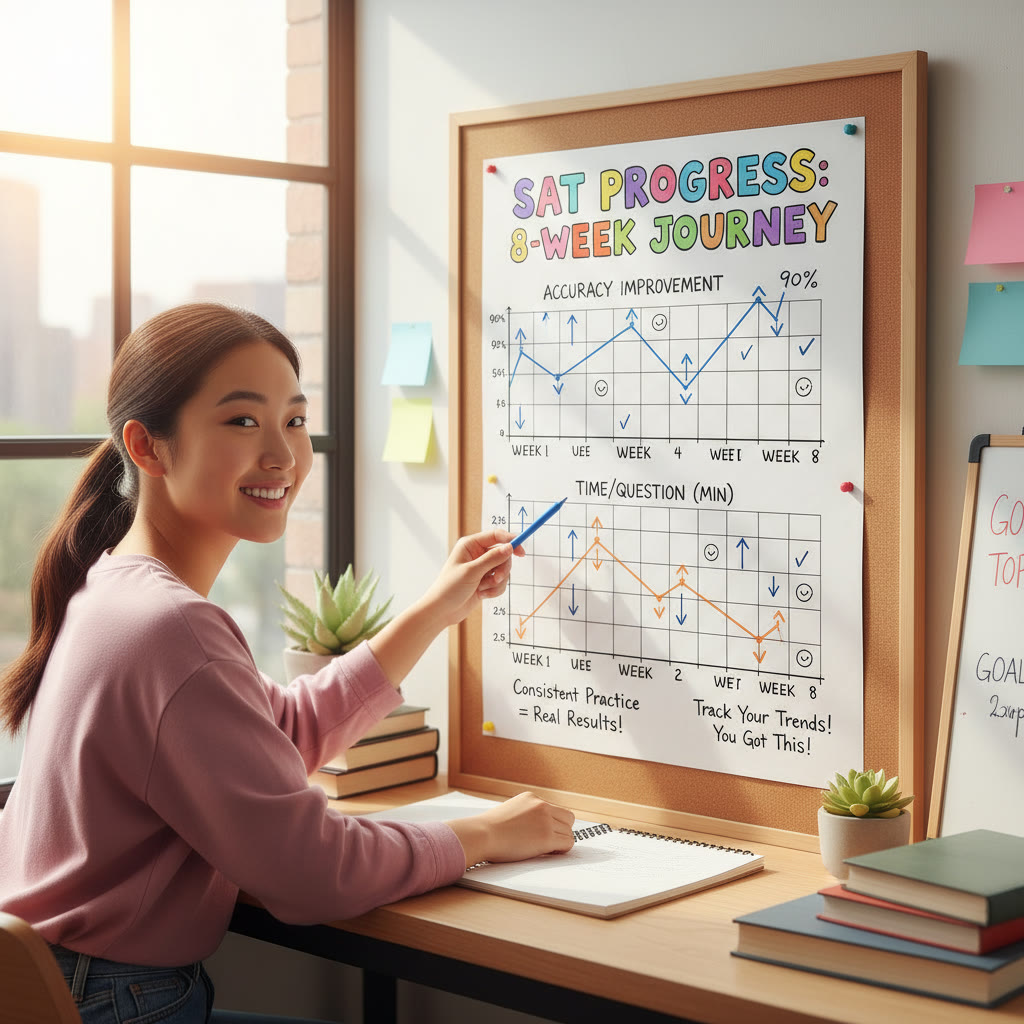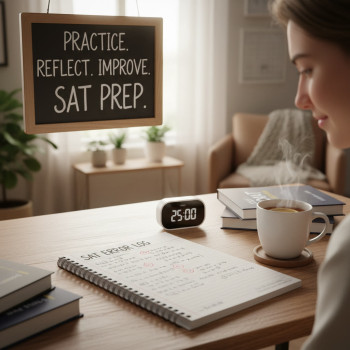How to Record and Review SAT Study Sessions for Real Improvement
Imagine this: you finish a three-hour practice block and feel pretty good. A week later you take a practice test and hit the same mistakes again. Frustrating, right? The missing link for many students is not more hours, but better reflection. Recording your SAT study sessions and reviewing them systematically turns raw effort into focused, measurable progress.
Why recording your sessions matters more than you think
Recording isn’t about making a documentary of your study life. It’s about creating repeatable evidence. When you capture what happened in a session — what questions you missed, how long a passage took, where anxiety crept in — you convert vague impressions into concrete data. With that data you can spot patterns, prioritize weak areas, and test whether your fixes actually work.
Studies of deliberate practice show that feedback is the engine of improvement. If you practice without feedback, you are likely reinforcing the same mistakes. Recording your sessions gives you that feedback loop: record, review, adjust, repeat.
What to record: the essentials
There are several layers of recording you can use. You don’t need to use them all — pick the combination that fits your style and time budget.
- Session metadata: date, start and end times, total duration, tasks planned.
- Task-level results: section (Math, Reading, Writing), number of questions, correct/wrong/omitted, time per question or passage.
- Behavioral notes: distractions, breaks, physical state (sleep, hunger), emotional state (anxious, confident).
- Thought process capture: audio or short video of you thinking aloud during hard problems, or typed notes about your reasoning.
- Timing and pacing data: timestamps for when you finished each passage or problem set.
- Key takeaways and action items: what to review next, error categories to target, and a mini-plan for the next session.
All of these pieces combine to create a study record that’s far richer than simple score tracking.
How to set up a recording system that won’t slow you down
Simplicity is the golden rule. If your system is fiddly, you’ll abandon it. Here’s a minimal setup and an advanced setup — pick the one that fits your commitment level.
- Minimal setup: paper notebook + phone timer. Write the date, section, time. Jot down 3 quick notes at the end: 1) biggest error, 2) timing issue, 3) one drill for next time.
- Advanced setup: spreadsheet + screen/audio recorder + phone. Use a Google Sheet or local spreadsheet to log question-level results and timing. Record your screen during official practice sections to preserve pacing and answer selection. Use a short audio recording for think-aloud when tackling hard problems.
Whichever you choose, keep it consistent. If you record one day but not the next, patterns will be harder to detect.
Tools you can use
- Phone voice recorder for quick think-aloud reflections.
- Screen recording (for digital practice tests) to capture answer choices and timing.
- Spreadsheet templates for session logs and aggregated analytics.
- Timer apps that allow splits so you can timestamp each passage or problem block.
- Smart notebooks or note apps for searchable session notes.

Step-by-step: recording during a typical 60–90 minute session
Here’s a practical drill you can try this afternoon. It’s designed to be realistic and easy to adopt.
- Plan (5 minutes): Decide on the focus. Example: Reading passage tone and evidence questions.
- Warm-up (5 minutes): A quick vocabulary or arithmetic warm-up to settle in.
- Practice block (40–60 minutes): Do two reading passages or a mix of 10–15 math problems. Use a timer and record split times for each passage/problem set.
- Immediate capture (5 minutes): Right after finishing, write or voice-record your raw reactions. Was a question unexpectedly hard? Did you slow down?
- Targeted review (10–20 minutes): Rework the questions you missed. Record the correct reasoning in short bullet form.
- Action items (3 minutes): Note one or two targeted drills for your next session.
That structure yields a compact record and helps you convert a single session into a repeatable experiment.
How to review recordings effectively
Not all review is created equal. A smart review looks for patterns, focuses on high-impact changes, and tests whether your adjustments work.
- First pass: within 24 hours, scan your session log to capture obvious errors and write 2–3 takeaways. These are immediate corrections.
- Second pass: after a week or two, review aggregated logs to detect patterns — e.g., frequent algebra mistakes, time bleed on long reading passages, careless errors on grid-ins.
- Third pass: monthly review. Look at trends in timing, accuracy, and question types. Compare before-and-after snapshots to see if specific drills reduced error rates.
When reviewing recordings, ask these questions:
- Which types of questions am I missing most often?
- When during a session do my errors spike — at the start, middle, or end?
- Are errors more conceptual (I don’t know the math) or procedural (I make careless mistakes)?
- Does fatigue or distraction correlate with worse performance?
Sample session log
Use the table below as a starting template. Fill it after each session so you build a searchable history.
| Date | Duration | Focus | Tools | Score / Accuracy | Key Takeaways |
|---|---|---|---|---|---|
| 2025-09-01 | 75 min | Reading: 2 passages (science, history) | Timer, voice memo | Correct 14/20 | Slow on evidence questions; need to underline key lines; add 15-min evidence drill |
| 2025-09-03 | 60 min | Math: algebra practice set | Spreadsheet, screen recording | Correct 11/15 | Careless signs errors; re-learn sign rules; do daily 10-minute algebra warm-ups |
How to extract patterns and prioritize drills
Once you have several session logs, you can code your mistakes into categories. Use simple tags like Concept, Careless, Timing, Misread, and Strategy. A few examples:
- Concept: I missed systems of equations because I forgot substitution shortcuts.
- Careless: I mis-copied a number from the passage into my scratch work.
- Timing: I spent 12 minutes on Passage 3 when the target is 8.
- Misread: I answered a question about the author’s tone but misread the qualifier.
After tagging 10–20 sessions, look for the highest frequency categories. If 40% of errors are timing-related, prioritize pacing drills. If many mistakes are conceptual, plan targeted concept reviews.
Using recordings to fix pacing and stamina
Pacing is one of the most misunderstood elements on test day. Many students either rush and make careless errors or slow down and run out of time. A recording that timestamps each passage or set of problems reveals true time distribution.
Try a pacing drill: record a full Reading section with timestamps. Afterward, calculate average time per passage and per question. If your average exceeds the recommended pacing, practice with a stricter timer and simulate test conditions. Over weeks, your timing should stabilize.
What to do with audio recordings of your thought process
Think-aloud audio is powerful. When you verbalize your reasoning during hard problems, you externalize the logic and make it easier to spot faulty steps.
How to use it without being intrusive:
- Keep it short. Use think-aloud for the toughest 2–3 problems in a session.
- Focus on reasoning, not just answers. Say the rule you’re using and why it applies.
- When reviewing, listen for repeated logic errors. For instance, if you keep relying on an incorrect shortcut, you’ll hear it repeatedly.
Audio recordings also record emotional signals — hesitations, speed of speech — which can tell you where confidence faltered.
Using recordings with a tutor or study partner
Recordings become even more valuable when reviewed with someone else. An expert tutor can quickly spot inefficient strategies that you might not notice. If you use Sparkl’s personalized tutoring, for example, sharing your session logs and recordings with a Sparkl tutor can make 1-on-1 guidance far more precise. Tutors can turn your raw recordings into tailored study plans, and Sparkl’s AI-driven insights can highlight patterns you might miss on your own.
When you meet with a tutor, go in with a clear agenda: show the recording or log, explain the recurring problem, and ask for a focused drill that targets the root cause. That kind of targeted work is what converts small gains into big score jumps.
Weekly and monthly review schedule
Here’s a simple schedule you can follow so recordings translate into consistent gains.
| Frequency | Activity | Goal |
|---|---|---|
| After each session | Quick capture: 3 takeaways and one action item | Keep a fresh record and immediate corrections |
| Weekly | Aggregate log review, tag errors, set weekly drills | Detect short-term patterns and adjust practice |
| Monthly | Deep review: look for trends in pacing, accuracy, and content gaps | Test whether interventions are working and recalibrate plan |
Real examples: three common scenarios
Seeing examples helps turn abstract advice into concrete moves. Here are three real student portraits and how recording helped them improve.
- Student A: The careless error trap. Their session logs showed many correct approaches ruined by simple arithmetic or sign errors. Solution: daily 10-minute accuracy drills, slow down on the first pass, and use a check routine. After four weeks, their accuracy rose by 8 percentage points.
- Student B: The pacing struggler. Recordings revealed that passages near the end of sections took significantly longer. Strategy: timed micro-practices with enforced stop points and a scribble strategy for question flags. Result: regained 12 minutes across sections and increased completed questions per section.
- Student C: The conceptual gap. Logs showed consistent misses on function notation and exponent rules. The fix was targeted concept sessions, then retesting. With recordings of their reasoning, the tutor could tailor explanations and the student saw consistent improvement on related questions.
Common pitfalls and how to avoid them
Recording is powerful, but certain mistakes can turn useful data into noise.
- Too much detail. If you try to capture every thought, review becomes overwhelming. Capture the signal, not the noise.
- Inconsistent logging. Sporadic records don’t reveal patterns. Build a habit: five short sessions logged per week is far better than one full session logged in depth every month.
- Analysis paralysis. Data is only useful if you act. After each review, choose one practical adjustment and test it in the next session.
- Blaming tools. A recording reveals issues — don’t treat it as a verdict on your ability. Treat it as actionable feedback.
Turning insights into a personalized plan
With consistent recording, your study plan becomes evidence-based. You can prioritize high-impact fixes: the grammar rule you miss repeatedly, the algebra technique that costs you time, or the pacing habit that makes you rush. If you want expert help translating recordings into a weekly plan, Sparkl’s personalized tutoring pairs tailored study plans and 1-on-1 guidance with AI-driven insights to concentrate practice on what actually moves the needle.
But even if you don’t use a tutor, the routine is the same: use recordings to form a hypothesis, run a focused experiment for 1–2 weeks, and measure whether your error rate changes.
Final tips to make recording feel natural
- Keep your logs short and consistent. Two lines of text or a 30-second voice memo is better than nothing.
- Schedule review time in your calendar. Treat it like homework that’s as important as the practice itself.
- Use visuals. A simple progress chart can be motivating; plot accuracy and average time per question each week.
- Be kind to yourself. Progress is incremental. Celebrate small wins—better timing on one passage, fewer careless errors in a session.

Conclusion: record with purpose, review with curiosity
Recording and reviewing SAT study sessions transforms practice from guesswork into experiment. You stop doing more of the same and start doing what works. The process is simple: capture the session, extract takeaways, implement one focused change, and measure the effect. Over time, these small, evidence-driven adjustments compound into meaningful score improvement.
Whether you keep notes in a notebook, use a spreadsheet, or share recordings with a tutor, the important part is the feedback loop. If you want a structured way to turn your recordings into a customized study plan, consider combining your logs with expert guidance. A tutor can accelerate the loop by translating recorded mistakes into targeted drills, and tools like Sparkl can add AI-driven insights and 1-on-1 feedback to make your practice time as efficient as possible.
Start today: record one short session, write three takeaways, and try a focused drill in your next session. Small moves, repeated with curiosity and data, are how big improvements happen.
Good luck — record wisely, review honestly, and keep building momentum.
















No Comments
Leave a comment Cancel